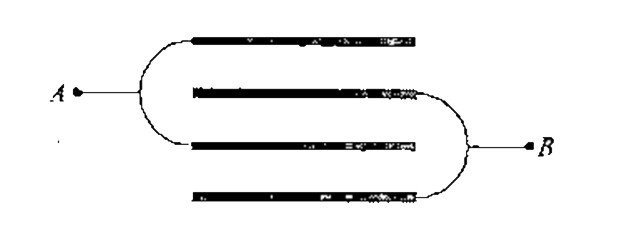A parallel plate capacitor is made by stacking n equally spaced plates connected alternatively. If the capacitance between any two adjacent plates is 'C' then the resultant capacitance is
(a) (n+1)C
(b) (n−1)C
(c) nC
(d) C
The correct Answer is:B
To solve the problem of finding the resultant capacitance of a parallel plate capacitor made by stacking n equally spaced plates connected alternatively, we can follow these steps:
1. Understanding the Configuration:
- We have n plates stacked on top of each other.
- The plates are connected alternatively, meaning that every two adjacent plates form a capacitor.
2. Identifying the Number of Capacitors:
- The number of pairs of adjacent plates (which form capacitors) can be calculated as n−1. This is because for n plates, there are n−1 gaps between them.
3. Capacitance of Each Pair:
- Each pair of adjacent plates has a capacitance of C.
4. Connecting Capacitors:
- Since the plates are connected alternatively, the capacitors formed between the plates are in parallel.
5. Calculating the Total Capacitance:
- For capacitors in parallel, the total capacitance Ceq is the sum of the individual capacitances:
Ceq=(n−1)×C
Final Result
Thus, the resultant capacitance between any two adjacent plates in this configuration is:
Ceq=(n−1)C
- We have n plates stacked on top of each other.
- The plates are connected alternatively, meaning that every two adjacent plates form a capacitor.
- The number of pairs of adjacent plates (which form capacitors) can be calculated as n−1. This is because for n plates, there are n−1 gaps between them.
- Each pair of adjacent plates has a capacitance of C.
- Since the plates are connected alternatively, the capacitors formed between the plates are in parallel.
- For capacitors in parallel, the total capacitance Ceq is the sum of the individual capacitances:
Ceq=(n−1)×C
Thus, the resultant capacitance between any two adjacent plates in this configuration is:
Ceq=(n−1)C
Topper's Solved these Questions
- BOOK - SUNIL BATRA (41 YEARS IITJEE PHYSICS)CHAPTER - ELECTROSTATICSEXERCISE - Subjective Problems2videos
ELECTROSTATICS
- BOOK - SUNIL BATRA (41 YEARS IITJEE PHYSICS)CHAPTER - ELECTROSTATICSEXERCISE - Comprehension Based Questions2videos
ELECTROSTATICS
- BOOK - SUNIL BATRA (41 YEARS IITJEE PHYSICS)CHAPTER - ELECTROMAGNETIC INDUCTION AND ALTERNATING CURRENTEXERCISE - JEE Main And Advanced107videos
ELECTROMAGNETIC INDUCTION AND ALTERNATING CURRENT
- BOOK - SUNIL BATRA (41 YEARS IITJEE PHYSICS)CHAPTER - MODERN PHYSICSEXERCISE - MCQ (One Correct Answer1videos
MODERN PHYSICS
Similar Questions
Figure shows four parallel plates kept at equal separation forming three parallel plate capacitors. The capacitance between two adjoining plates is C. Find out equivalent capacitance between A and B.
 View Solution
View SolutionIn a parallel plate capacitor with air between the plates, each plate has an area of 6×10−3m2 and distance between the plates is 3mm. Calculate the capacitance. If this capacitance is connected to a 100V supply, what is the charge on each plate of the capacitor ?
View Solution
Knowledge Check
- Question 1 - Select One
n equally spaced plates are stacked to make a parallel plate capacitor. If-C is the POLES, capacitance between two adjacent plates, the resultant capacitance is :
AnCBn2CC(n−1)CDCn - Question 2 - Select One
A parallel plate capacitor has 91 plates, all are identical and arranged with same spacing between them. If the capacitance between adjacent plates is 3 pF. What will be the resultant capacitance?
A273 pFB30 pFC94 pFD270 pF - Question 3 - Select One
A parallel plate capacitor is filled with dielectrics. What is capacitance?
 A2K1K2K1+K2BK1K2K1+K2C2ε0Ad(K1K2K1+K2)D2ε0Ad(2K1+K22K1K2)
A2K1K2K1+K2BK1K2K1+K2C2ε0Ad(K1K2K1+K2)D2ε0Ad(2K1+K22K1K2)
A variable capacitor has n plates and the distance between two successive plates is d. determine its capacitance.
View SolutionA parallel plate capacitor with air between the plates has a capacitance of 10 pF. The capacitance, if the distance bgetween the plates is reduced by half and the space between tehm is filled with a substance of dielectric constant 4 is
View SolutionA parallel plate capacitor of capacitance C is charged to a potential V and then disconnected with the battery. If separation between the plates is decreased by 50% and the space between the plates is filled with a dielectric slab of dielectric constant K=10. then
View SolutionA parallel plate capacitor with air between the plates has a capacitance C. If the distance between the plates is doubled and the space between the plates is filled with a dielectric of dielectric constant 6, then the capacitance will become.
View SolutionIn a parallel plate capacitor, the capacitance
View Solution

